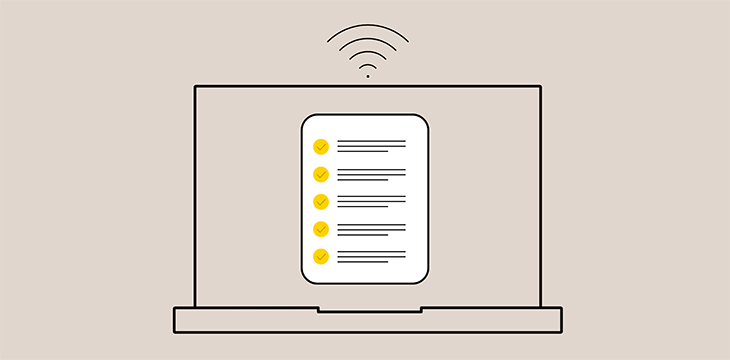
Recent years have accelerated the emergence of remote work globally, a trend that had already started a few time ago. Employers considering making this practice a more permanent one have just one concern: ensuring business continuity, even when the work is done from a distance. Is your company looking to prolong the teleworking experience? Here are five tips to achieve your goals while maintaining your productivity levels.
Here are five tips to achieve your goals while maintaining your productivity levels.
1. Collaborating . . . beyond Zoom
Mainstream cloud-based tools like Zoom and Microsoft Teams have greatly facilitated the migration to telework. The first advantage for companies and employees is access to leading edge IT services and applications without having to pay to maintain their functionality, since they’re operated by third parties. Using these tools at home, employees can maintain a high level of productivity since they’re only a few clicks away from all their work tools.
To be sustainable, remote work requires more than just the ability to make occasional video calls between co-workers through mainstream applications. When colleagues need to share crucial data, or when more formal presentations for clients or potential business partners are necessary, employers immediately seek out tools that are undeniably reliable. Videotron Business’ professional grade collaborative solutions can effectively meet this remote work need.
“Even if there’s no one left at the office to handle communications, it’s a solution that guarantees business continuity. Obviously you still have to respect established standards for certain things, like security and availability, but the solution has to facilitate sharing and collaboration between co-workers,” explains Charles Migabo, Senior Manager, Products and Strategies, at Videotron Business.
To this end, Videotron Business has developed a package for businesses that includes collaboration tools and traditional telecommunication services (mobile phone, Internet). It includes a conferencing, audio and video calling platform that enables 15 co-workers to virtually convene as if they were still at the office. This platform is supported by a chat tool and availability indicator, which ensures that the people you want to contact can accept your call.
This is a multi-platform solution, available for Mac, PC, or mobile, and also includes more traditional features, such as voice phone and unified voicemail, just as if you were still at your office desk.
2. Choose a tailored, unified communications platform
Moreover, whether your company is in favour of teleworking or not, the possibility of being able to migrate your technological tools to the cloud will also enable you to deploy a unified communications strategy, with a single point of contact to reach every member of your organization. “For example, each employee can have their own unique phone number, linked to their mobile phone, tablet, computer, and office phone,” illustrates Martin Lefrançois, Director of Network Product Development at Videotron, in a blog post highlighting the advantages of cloud-based services.
The mobility promised by these technologies had formerly been reserved only for big companies, but now SMEs can take advantage of a made-to-measure offer adapted to their size. These tools work for any budget and offer greater operational flexibility not only for employees working from home, but also for those who need to travel across the province or country to meet with clients or business partners.
Since applications and data are accessible at all times from a computer or smartphone, in a secure manner, these mobile workers are at no risk of misplacing presentation materials—all they need to do is connect to their company account to recover the documents they need.
In the end, working from home is really no different than any other type of remote work enabled by the new business mobility, in which mobile services are at least just as important as the devices themselves.
3. Ensuring blackout-proof, professional-grade connectivity
The quality of your Internet connection at home may fluctuate, or even suffer a blackout. How can you guarantee that an employee working remotely can be productive if they don’t have access to tools and documents stored on company servers? By opting for a professional-grade connection, one based on redundant connectivity that can take over if the main connection suddenly stops working.
“It’s a backup that connects to your wireless network, thus reducing your risk of a power outage and acting as a reliable insurance policy for your Internet access. It’s a service that is entirely manageable and kicks in automatically when need be,” adds Charles Migabo. “This means your teleworkers always have access to your tools, documents, and services.”
With such a service, your productivity becomes immune to potential power outages in situations such as teleworking, where the availability and quality of an Internet connection is vital.
4. Protecting your business against cyber threats
It is essential that you implement safety tools to protect yourself and your employees—whether you’re working from home or in the office. Videotron Business’ unified cyber-security service offers centralized management, applying industry best practices in terms of cyber-security at large.
This approach ensures the security of both employers and employees, whether they are working at the head office or remotely. It also includes redundancy for the office connection and an antivirus that is continually and automatically updated, without the need for intervention by an employee on their computer, tablet, or smartphone, who won’t have to worry about such technical details.
Employees won’t even have to worry about whether their home router will meet their professional needs, since this unified service includes the installation of a business-class router, which ensures optimal connectivity and is equipped with a firewall that is always up to date on the latest cyber threats.
“In fact, we go above and beyond UTM, we do more than preventing fraudulent sites and malware. What we offer is really a next-generation cyber-security solution, which is ready for the development of the Internet of things,” says Migabo. “We protect the IT network, computers, tablets, and smartphones of all your employees.”
5. Protecting the employer and employee by choosing the right VPN
The cornerstone of a secure connection is a virtual private network, or VPN. This is an encrypted remote connection protocol based on the company’s servers. It’s a secure extension of your internal network that provides access to applications and data that are usually available at the office, using any type of Internet access.
You can therefore access your company’s marketing tools (CRM, ERP, etc.) from home, just as easily as you would if you were at the office. What’s more, a VPN is often used by companies with facilities in several different locations to unite all their operations on the same network, making the sharing of data and resources both simpler and more secure. A VPN has advantages that make it useful both for employees and the company, but not necessarily for the same reasons. Since the data sent by a user through such a connection are encrypted, the user benefits from a secure, anonymous connection. On the other hand, a company VPN encrypts the exchange of data between the user and the company’s own servers.
A VPN is a sure way to safely share information while teleworking, thereby avoiding recourse to external third-party services, like cloud-based data hosting sites, which don’t fulfill business security or confidentiality criteria.
A VPN server encrypts data sent through your network, a feature that requires certain resources. With the evolution of remote work technologies, many enterprise VPNs have been optimized to handle an increasing number of simultaneous users without compromising speed or security. “A company that suddenly sends a hundred employees home to telework needs to ensure that its firewall is adapted for this,” explains Pascal Allard, Senior Manager of Engineering and Sales at Fibrenoire. Today, advanced firewall and VPN solutions provide increased flexibility and security, even with a large number of simultaneous connections.
In contrast, VPN services for companies have a price range that is adapted to the needs of organizations with dozens of users. Some services prefer to offer a fixed price per user or group of users, but a made-to-measure formula can be more economical, depending on the situation.
One thing is certain: Adopting remote work for the long term requires new habits and new behaviours, for both employees and the employer. After all, working on a laptop sitting on the edge of the kitchen table is simply not sustainable… and what’s important for a workstation is also important for a company’s entire IT infrastructure, which needs to be open to new ways of working. Although the immediate impact of the COVID-19 pandemic is behind us, companies continue to adopt remote work solutions to meet evolving needs.
The key to success, for those organizations hoping to benefit from the switch, is to know how to find the right tools for ensuring their business continuity. These tools will be as much the business of workers, who will continue to be productive, as of managers, who can use them to supervise—and secure—everything in the blink of an eye.
5 tips to remember
- Collaborating . . . beyond Zoom
- Choose a tailored, unified communications platform
- Ensuring blackout-proof, professional-grade connectivity
- Protecting your business against cyber threats
- Protecting the employer and employee by choosing the right VPN
Updated septembre 2024, By Videotron Business
Join the community
We're here to help
References
Sources : Selligent, Forrester Research






